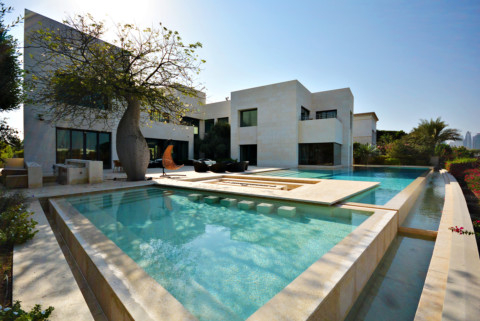
Aspirational residences in Dubai are often located in newer areas. Examples of such residential hotspots include Emirates Hills, Dubai Marina and Downtown Dubai. Despite newer communities being launched with enviable facilities and better amenities, experts say some older residential areas remain attractive to residents. On the other hand, locations such as Bur Dubai and Karama continue to hold their appeal and rental prices.
David Godchaux, CEO, Core-Savills classifies some of these areas as “historically core” where “long-term investors and occupiers who are keen on the central locations are the ones holding interest”.
He adds, “The mainstream market displayed disparity with a few areas marking a rise, while others observed a ‘double dip’.”
Godchaux says that outlying areas such as Dubailand and Dubai Sports City have maintained a relatively stable upward momentum. Meanwhile, Discovery Gardens displayed a classic case of double dipping, with newer developments being delivered in close proximity at very competitive prices.
“Interestingly, after leading the recovery trend for the villa districts, The Springs and The Meadows marked a slowdown due to the trickle-down effect of Mira’s delivery in Reem,” says Godchaux.
Meanwhile, the Q2 2017 Dubai Residential Market Update by Core Savills Research states, “On the desirability scale for buyers, the core apartment districts of Dubai Marina, Jumeirah Lakes Towers [JLT], The Views and The Greens continue to witness steady transaction activity. Nevertheless, outer areas are seeing the most number of supply deliveries and only a few buildings in Jumeirah Village, Dubailand and Al Furjan gained traction from price-conscious buyers.”
Not only does this reflect on prices, but also the speed with which properties in desirable locations are picked up. “Units marked up at competitive rents in core locations such as Dubai Marina, JLT, The Greens and The Views are absorbed within two to three weeks of them coming to the market, reflecting an active rental market in core locations,” according to the report.
Affordably desirable
During the first half this year, increased transaction activity at the non-premium end of the market has meant that sales prices in some areas have maintained their levels. On the other hand, luxury property has suffered.
“Right now there is nervousness around commitment to luxury property in the world. Dubai is not an exception to that,” Faisal Durrani, global head of research at Cluttons, tells PW, adding that year-on-year prices of apartments in Burj Khalifa were down by 25 per cent, while in Palm Jumeirah villas saw a 15-18 per cent decline.
“These are the weakest-performing markets and the more expensive properties in Dubai,” says Durrani. “On the other hand, in places like International City and Discovery Gardens values have not moved at all in the last 12-18 months.”
Affordability has become key to price corrections, with the properties that are priced at a certain level holding their values. Godchaux tells PW, “Rentals have continued to soften across the board, with an exception marked in Dubailand, possibly due to their lower entry-level rents.
“There is statistical bias in calculating rental drops, as the market is largely transacting at the lower end of the spectrum, bringing the area average down. That said, rental contractions are felt across 18 of the 19 sub-markets that we track.”
Referring to data assessing rental performance across low-end, mid-range and high-end properties from 2010-17, Durrani says, “There is huge demand for key worker accommodation — this is not labour accommodation. These are people who drive the economy — shop assistants, hair dressers and many, many others.
“In the 1950s and 1960s this housing stock was created at the edge of old Dubai. Now it is in the middle of the city. There is huge demand for affordable housing in proximity to transport.”
According to data supplied by Cluttons, low-end areas, including International City, IMPZ, Discovery Gardens, Jumeirah Village Circle, Jumeirah Village Triangle, Sports City, JLT and Dubailand apartments, have maintained average rents just below Dh60,000 per year in Q1 2010 to about Dh50,000 in Q1 2017, dipping to a low of Dh31,000 in Q4 2011. This is a much smaller range compared with high-end apartments in Downtown Dubai, Dubai Marina, Palm Jumeirah and Dubai International Financial Centre, where the highest average rents touched approximately Dh166,000 in Q1 2010, to Dh145,000 in Q1 2017. At their lowest, they dipped to Dh105,000 in Q2 2011.
Meanwhile, areas with affordable housing appear to have less pronounced dips and spikes compared with the emirate’s average. International City has 22,000 residential units and a population of approximately 60,000, whereas Discovery Gardens consists of 26,000 residential units (291 buildings) and a population of about 60,000. Karama, tagged as Dubai’s first affordable housing neighbourhood, houses approximately 76,000 people.
Supply-led demand
There are other measures for desirability, including supply, in some cases. Citing Downtown Dubai, Durrani says, “There has been no change in prices in Downtown in the past 12 months. There were only 1,500 new homes launched in the last year, compared to 2,200 in 2015. There is a 45 per cent drop in the number of launches because of limited space. The chance to buy first-time property is diminishing. That will support stability.”
As sales go, Godchaux says there is a healthy variation even in transaction activity. “Our Q2 Residential Report for Dubai reveals that the core apartment districts of Dubai Marina, JLT, The Views and The Greens continue to witness a steady transaction activity,” he says, while noting that only some building in areas farther out are attracting budget-conscious buyers. “In the villa market, we have seen higher movement in the low to mid-market segment of Jumeirah Village and Mira, while the central villa districts of The Springs and The Meadows have seen enduring demand over the last few quarters.”
Overall, Dubai’s real estate market continues to elude being typecast, forcing investors to formulate their strategy according to the sub-location they are considering. “In a market where a significant section of occupiers are transient, we see several factors having impacts on the sub-market dynamics such as seasonality, change in regulations, developer’s strategies and, of course, launch and delivery of new stock,” according to the Core-Savills report. “With this variety of drivers, a clear direction on recovery is yet to emerge, with only a few locations consistently marking an upward creep.”











